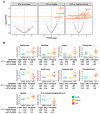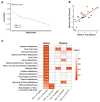Characterization of Salivary and Plasma Metabolites as Biomarkers for HCC: A Pilot Study
- PMID: 37760495
- PMCID: PMC10527521
- DOI: 10.3390/cancers15184527
Characterization of Salivary and Plasma Metabolites as Biomarkers for HCC: A Pilot Study
Abstract
(1) Background: The incidence of hepatocellular carcinoma (HCC) is rising, and current screening methods lack sensitivity. This study aimed to identify distinct and overlapping metabolites in saliva and plasma that are significantly associated with HCC. (2) Methods: Saliva samples were collected from 42 individuals (HCC = 16, cirrhosis = 12, healthy = 14), with plasma samples from 22 (HCC = 14, cirrhosis = 2, healthy = 6). We performed untargeted mass spectrometry on blood and plasma, tested metabolites for associations with HCC or cirrhosis using a logistic regression, and identified enriched pathways with Metaboanalyst. Pearson's correlation was employed to test for correlations between salivary and plasma metabolites. (3) Results: Six salivary metabolites (1-hexadecanol, isooctanol, malonic acid, N-acetyl-valine, octadecanol, and succinic acid) and ten plasma metabolites (glycine, 3-(4-hydroxyphenyl)propionic acid, aconitic acid, isocitric acid, tagatose, cellobiose, fucose, glyceric acid, isocitric acid, isothreonic acid, and phenylacetic acid) were associated with HCC. Malonic acid was correlated between the paired saliva and plasma samples. Pathway analysis highlighted deregulation of the 'The Citric Acid Cycle' in both biospecimens. (4) Conclusions: Our study suggests that salivary and plasma metabolites may serve as independent sources for HCC detection. Despite the lack of correlation between individual metabolites, they converge on 'The Citric Acid Cycle' pathway, implicated in HCC pathogenesis.
Keywords: biomarkers; cancer; hepatocellular carcinoma; liver disease; metabolomics.
Conflict of interest statement
D.M.R. has an equity stake in Clarified Precision Medicine, LLC. D.M.R., F.A., D.S.A. and C.H. hold intellectual property related to the detection of hepatocellular carcinoma.
Figures



Similar articles
-
Biomarker Discovery in Liver Disease Using Untargeted Metabolomics in Plasma and Saliva.Int J Mol Sci. 2024 Sep 21;25(18):10144. doi: 10.3390/ijms251810144. Int J Mol Sci. 2024. PMID: 39337628 Free PMC article.
-
Salivary Metabolites are Promising Non-Invasive Biomarkers of Hepatocellular Carcinoma and Chronic Liver Disease.Liver Cancer Int. 2021 Aug;2(2):33-44. doi: 10.1002/lci2.25. Epub 2021 May 20. Liver Cancer Int. 2021. PMID: 34541549 Free PMC article.
-
Metabolomics biomarkers of hepatocellular carcinoma in a prospective cohort of patients with cirrhosis.JHEP Rep. 2024 May 15;6(8):101119. doi: 10.1016/j.jhepr.2024.101119. eCollection 2024 Aug. JHEP Rep. 2024. PMID: 39139459 Free PMC article.
-
Disease monitoring of hepatocellular carcinoma through metabolomics.World J Hepatol. 2017 Jan 8;9(1):1-17. doi: 10.4254/wjh.v9.i1.1. World J Hepatol. 2017. PMID: 28105254 Free PMC article. Review.
-
Salivary metabolomics for the diagnosis of periodontal diseases: a systematic review with methodological quality assessment.Metabolomics. 2021 Jan 1;17(1):1. doi: 10.1007/s11306-020-01754-3. Metabolomics. 2021. PMID: 33387070
Cited by
-
Multi-Omic Analysis Reveals a Lipid Metabolism Gene Signature and Predicts Prognosis and Chemotherapy Response in Thyroid Carcinoma.Cancer Med. 2025 Mar;14(6):e70819. doi: 10.1002/cam4.70819. Cancer Med. 2025. PMID: 40119647 Free PMC article.
-
Causal effects of plasma metabolites on autoimmune hepatitis (AIH): a bidirectional two-sample mendelian randomization study.Sci Rep. 2024 Oct 3;14(1):22944. doi: 10.1038/s41598-024-74387-4. Sci Rep. 2024. PMID: 39362997 Free PMC article.
-
Biomarker Discovery in Liver Disease Using Untargeted Metabolomics in Plasma and Saliva.Int J Mol Sci. 2024 Sep 21;25(18):10144. doi: 10.3390/ijms251810144. Int J Mol Sci. 2024. PMID: 39337628 Free PMC article.
-
Multi-Omics Assessment of Puff Volume-Mediated Salivary Biomarkers of Metal Exposure and Oxidative Injury Associated with Electronic Nicotine Delivery Systems.Environ Health Perspect. 2025 Jan;133(1):17005. doi: 10.1289/EHP14321. Epub 2025 Jan 16. Environ Health Perspect. 2025. PMID: 39819025 Free PMC article.
-
Metataxonomics and Metabolomics Profiles in Metabolic Dysfunction-Associated Fatty Liver Disease Patients on a "Navelina" Orange-Enriched Diet.Nutrients. 2024 Oct 18;16(20):3543. doi: 10.3390/nu16203543. Nutrients. 2024. PMID: 39458536 Free PMC article.
References
-
- Tzartzeva K., Obi J., Rich N.E., Parikh N.D., Marrero J.A., Yopp A., Waljee A.K., Singal A.G. Surveillance Imaging and Alpha Fetoprotein for Early Detection of Hepatocellular Carcinoma in Patients With Cirrhosis: A Meta-analysis. Gastroenterology. 2018;154:1706–1718.e1. doi: 10.1053/j.gastro.2018.01.064. - DOI - PMC - PubMed
Grants and funding
LinkOut - more resources
Full Text Sources

